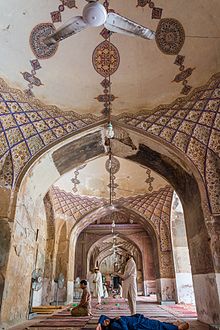Begum Shahi Mosque
|
Mosque of Mariyam Zamani Begum بیگم شاہی مسجد |
|
|---|---|

The building is Lahore's earliest dated Mughal period mosque.
|
|
| Basic information | |
| Affiliation | Islam |
| District | Lahore |
| Province | Punjab |
| Country |
Pakistan |
| Architectural description | |
| Architectural type | Mosque |
| Architectural style | Indo-Islamic/Mughal |
| Groundbreaking | 1611 |
| Completed | 1614 |
| Specifications | |
| Dome(s) | 3 |
| Materials | Brick |
Begum Shahi Mosque (Urdu: بیگم شاہی مسجد), officially The Mosque of Mariyam Zamani Begum (Urdu: مریم زمانی بیگم کی مسجد), is an early 17th-century mosque situated in the Walled City of Lahore, Punjab, Pakistan. The mosque was built between 1611 and 1614 during the reign of Mughal Emperor Jahangir in honour of his mother. It is one of Lahore's earliest surviving examples of a Mughal-era mosque, and influenced construction of the larger Wazir Khan Mosque a few decades later.
The mosque has been encroached upon by several shops, and views of the mosque from the Akbari Gate of the Lahore Fort have been obstructed by illegally constructed tyre shops. In July 2016, the Walled City of Lahore Authority announced that the shops would be removed, and the mosque would also be conserved and restored.
The mosque was built during the reign of Mughal Emperor Jahangir in the honour of his mother, Begum Mariyam Zamani, who was also known as 'Maharani Jodha Bai'. Mariyam Zamani was also a wife of Mughal Emperor, Akbar.
The mosque is located inside the old Masti Gate in the Walled City of Lahore.
Construction began in 1611 and lasted until 1614. The Mosque of Mariyam Zamani was temporarily turned into a gunpowder factory by Maharaja Ranjit Singh, for which it was then known as Barudkhana Wali Masjid ("Gunpowder Mosque"). In 1850 the mosque was returned to the Muslims of Lahore who were able to contribute to its renovation.
...
Wikipedia
